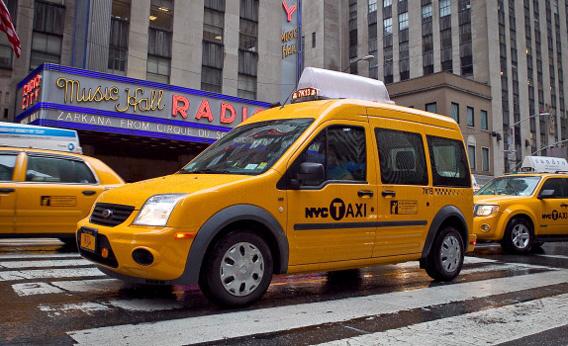Uber is a company that’s exciting, innovative, useful, and arguably shouldn’t exist at all. It is a solution to a ridiculous problem created by cartels and overregulation.
“I wanted to be able to press a button and get a classy ride,” explained CEO Travis Kalanick when I asked him to describe Uber’s origin story to me at a launch event for its D.C. branch on Wednesday. So last year Kalanick, Oscar Salazar, and Garrett Camp founded a company originally known as UberCab in San Francisco.
The original name made perfect sense, since at root what Uber provides is a taxi service. Just about every major city in America has, in addition to its heavily regulated cab drivers, a largish fleet of private sedan drivers who do things like take businessmen on pre-arranged drives to and from airports. These limo services generally feature nicer cars, higher prices, and—crucially—different moments of peak demand. Car services get a lot of business weekday mornings, and to a lesser extent in the afternoon rush hour. But very few business travelers need a ride from the airport late on a Friday or Saturday night, which is the time lots of drunk young people want a ride home or maybe to a different bar.
These are two fairly distinct market segments. Airplanes take off and land at defined times, meaning that people need the predictability that comes with pre-arranged rides. Bar-hopping (or perhaps a decision to take a new friend home at the end of the evening) almost by definition happens on the spur of the moment. Hence the distinction between the cars you schedule a pickup with and the “cab” you hail on the street.
Since the scheduled sedans aren’t actually in use during the peak cab demand periods, in principle the drivers ought to be able to make extra money by picking up more spontaneous passengers. This is where Uber comes in.
You use Uber by creating an account, logging in with your credit card information, and downloading an app to your smartphone. Then when you want a ride, you fire up the app. It uses your phone’s GPS and Uber’s sophisticated traffic models to tell you how close the nearest car is (always less than 10 minutes away during my three field tests) and if you like the proposition, you press the button. When your ride is ready, you get a text message—letting you wait for the car without leaving the comfy confines of your party/bar/house to stand exposed to the elements—and then you hop in. The driver takes you where you want to go, and out you hop. Billing is automated via the information you already provided and tip is included. Uber, meanwhile, doesn’t actually own any cars or employ any drivers. It’s just a booking service that takes a commission for facilitating the transaction.
All in all, it’s a very neat service. But it raises a fairly fundamental question. If the problem is that at certain times of day people want to hail more cabs than there are available, while simultaneously there’s an excess supply of sedans, why don’t the sedan drivers just cruise around and let people flag them down curbside?
Such things do happen, of course. I’ve even done it myself. But don’t call the cops: It’s illegal!
What is legal (apparently) is for sedan drivers to cruise around and let people use smartphone apps to “schedule” a pickup moments in advance. It’s an extremely elegant use of technology to, in effect, hack the legal system. Through the magic of computer power, a sedan becomes a cab without changing its technical legal status. Naturally, Uber’s executives dispute this characterization. The giveaway, however, is that UberCab was the original name until it was changed under pressure from the San Francisco Municipal Transportation Agency.*
To be clear, I’m not accusing Uber of doing anything illegal. What they are doing, however, is running a business that would have bleak prospects of success if our nation’s taxi laws were not so dumb. One of Uber’s stronger markets, for example, is Boston, a city that features exorbitant fares and low taxi availability in part because Cambridge cabs can’t pick up passengers in Boston and vice versa. Uber, unbound by such restrictions, can operate its vehicles much more efficiently. Here in D.C. we have some of the lowest taxi fares of any major American city, which might make it hard for Uber to get a toehold with its premium prices. But the Taxi Commission is raising fares anyway as the mayor’s payback for cabbies’ electoral support during the 2010 primary, which should give Uber a fighting chance.
Meanwhile, in New York City where the taxi medallions allowing cabs to pick up passengers curbside are so scarce that they sell for a million dollars, the Bloomberg administration put on the table a sensible proposal to let licensed sedans pick up passengers in the outer boroughs. But the governor and the state legislature—under pressure from the taxi industry—have been resisting the proposal and the fate of even a watered-down version remains uncertain. A veto would, clearly, be great news for Uber. So while I’m excited about this company and wish it well in generally, what I really want is for us to improve our policies. Make drivers get licenses, by all means. And regulate cars for safety and emissions standards. But beyond that, let as many people give rides to other people as want to. And let them charge what they want to charge. It’s an idea so right-wing and radical that they do it in Sweden.
Correction, Dec. 19, 2011: This article originally referred to the non-existent San Francisco Metro Transit Authority rather than the San Francisco Municipal Transportation Agency. (Return to the corrected sentence.)
